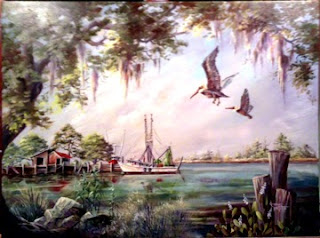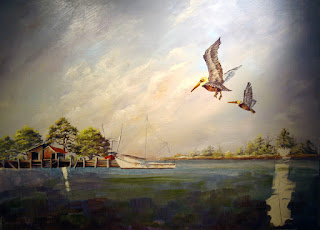A friendship event...
inspired by the living we share with others.
This summer a few of us from Georgia, Alabama and Kentucky met in Atlanta to spend a few days with Brenda, one of our artist friends. Over the years there have have taken classes together in Alabama, Mississippi, Georgia and Florida.
Thru these classes, we have developed so many wonderful lasting friendships.
Brenda has been fighting cancer this year and not able to be with us to paint in the classes, so three of us Sandra, June and myself got together and went to her home.
There with her husband, Travis, who has a humorous tolerance of our habits, we
took turns preparing the evening meals talking about old times and painting.
Brenda's beautiful home and her gracious Southern hospitality made us all feel instantly at home.
Our first activity was to shop at Hobby Lobby for supplies. We chatted like birds as we looked for anything we had never used... a treasure hunt of sorts. We soon discovered the black canvases. They had just enough for us to get one for a special project for our "celebration of life" week.
It seemed fitting that we try something new....
We had painted on a "tinted ground" or toned canvas about 15 years ago at Wakulla Springs, Florida. We used acrylic paint to tone the white canvas to a peachy pink to enhance our warm evening view of the gazebo in front of the Lodge.
Fresh peaches in Brenda's kitchen were beautiful in a white porcelain berry bowl.
When painting in Florida, we usually visit the pottery studio of George Griffin in Sopchoppy. George's pottery is highly sought by collectors who appreciate good pottery. George does not do art shows making it a real treat to visit his studio for treasures.
Brenda's pottery collection brought back many memories for all of us, including the time we painted George's chickens! It began to rain that afternoon so we had to move to a pavillon at Otter Lake to finish.
This painting project was now a trip down memory lane as we recounted several of our more eventful experiences... and there have been quite a few!
It would be a great treat to add a piece of George's pottery to our still life.
We added a few figs picked that morning as we strolled Brenda's garden, eating fruit along the way.
We now had a very meaningful arrangement of items that celebrated our many years of painting together.
Artists always paint better when working on subjects with personal meaning.
The black canvas was a fun event. The dark tone does not show through much at all but adds a "unity of colour." After I finished my 8 x 10 canvas, a black frame from Hobby Lobby was a perfect addition to the art.
For those who do not paint,
you can see from this simple accounting how special and meaningful a small painting can be.
Our time together was a wonderful celebration of each of our lives together and the times we have shared over the years.
A special thanks to Brenda and her husband, Travis for inviting us to visit in their wonderful home. Brenda looks wonderful. Her energy is amazing and she inspires us all !
Make every day count... these are the good days!
Donna Peters
For information on my next workshops, drop me an e-mail so I can add you to my list to notify.
Classes are limited in size. Beginners are just as welcome as the seasoned artists.
Donna Peters, artist
Deep South Studio
P.O. Box 10
Crane Hill, AL 35053
256-747-4141
e-mail: donnapeters@mindspring.com












































